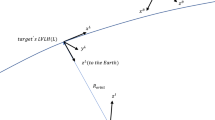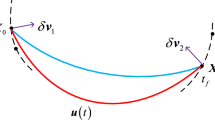Abstract
In this paper, a robust orbit design approach under constant thrust is proposed based on the relative motion dynamic model. First, the design problem is cast into a convex optimization problem by introducing a Lyapunov function subject to linear matrix inequalities. Next, the robust controllers satisfying the requirements can be designed by solving this optimization problem. At last, the proposed method has the advantage of saving fuel is proved and the actual constant thrust switch control laws are obtained through the isochronous interpolation method, an illustrative example is provided to show the effectiveness of the proposed control design method.
Access provided by Autonomous University of Puebla. Download conference paper PDF
Similar content being viewed by others
Keywords
2.1 Introduction
New challenges arise from the International Space Station (ISS) and the numerous formation flight projects [1, 2]. The close range rendezvous phase is usually divided into two subphases: a preparatory phase leading to the final approach corridor and a final approach phase leading to the mating conditions. The objectives of the close range rendezvous phase are the reduction of the range to the target and the achievement of conditions allowing the acquisition of the final approach corridor [3]. This means that at the end of this phase the chaser is, concerning position, velocity, attitude, and angular rates, ready to start the final approach on the proper approach axis within the constraints of the safety corridor [4, 5].
The rendezvous problem has been extensively studied as an optimal control problem [3, 6]. Both impulsive thrust and the continuous thrust assumptions have been exploited through the Pontryagin’s maximum principle, respectively. In actual practice, maneuver during rendezvous and docking operations cannot normally be considered as continuous thrust or impulsive maneuver. In our previous study, constant thrust fuel-optimal control for spacecraft rendezvous was studied according to the C-W equations and the analytical solutions. But the traditional open-loop control method used in our previous studies is not applicable while they are often utilized during the long-distance navigation process. To overcome this problem, a robust closed-loop control law for constant thrust rendezvous to enhance the orbital control accuracy is proposed in this paper. And the fuel consumption of constant thrust is less than that of the continuous thrust by using the method proposed in this paper.
2.2 Multiobjective Robust Controller Design
The relative motion coordinate system can be established as follows: first, the target spacecraft is assumed as a rigid body and in a circular orbit, and the relative motion can be described by Clohessy-Wiltshire equations. Then, the centroid of the target spacecraft \( O_{T} \) is selected as the origin of coordinate, the x-axis is opposite to the target spacecraft motion, the y-axis is from the center of the earth to the target spacecraft, and the z-axis is determined by the right-handed rule.
where \( \omega \) represents the angular velocity. \( F_{x} ,F_{y} ,F_{z} \) represent the vacuum thrust of the chaser, \( \eta_{x} ,\eta_{y} ,\eta_{z} \) represent the sum of the perturbation and nonlinear factors in the three axes, respectively. m represents the mass of the chaser at the beginning of the rendezvous. Suppose that the maximum thrusts are \( \overset{\lower0.5em\hbox{$\smash{\scriptscriptstyle\frown}$}}{F}_{x} ,\overset{\lower0.5em\hbox{$\smash{\scriptscriptstyle\frown}$}}{F}_{y} ,\overset{\lower0.5em\hbox{$\smash{\scriptscriptstyle\frown}$}}{F}_{z} \) and the theoretical thrusts are \( F_{x}^{*} ,F_{y}^{*} ,F_{z}^{*} \). The range of the thrust angle in the x-axis \( \theta_{x} \) is defined as shown in Fig. 2.1.
The goal of the rendezvous maneuver is to design a proper controller for the chaser, such that the chaser can be asymptotically maneuvered to the target position. Define the state error vector \( x_{e} (t) = x(t) - x_{t} (t) \), and its state equation can be obtained as
Lyapunov function is defined as follows:
where P is a positive definite symmetric matrix. According to the system stability theory, the necessary and sufficient conditions for robust stability of the system (2.3) are as follow:
Then a multiobjective controller design strategy is proposed by translating a multiobjective controller design problem into a convex optimization problem. And the control input constraints can be met simultaneously. Assuming the initial conditions satisfy the following inequality, where \( \rho \) is a given positive constant.
Theorem 2.1
If there exist a corresponding dimension of the matrix L, a symmetric positive definite matrix X, and two parameters \( \varepsilon_{1} > 0,\varepsilon_{2} > 0 \) , then the sufficient condition for robust stability is there exist a state feedback controller K which can meet the following conditions simultaneously.
where \( \Sigma = XA_{0}^{T} + A_{0} X + L^{T} B_{0} + B_{0} L + \varepsilon_{1} \alpha^{2} I + \varepsilon_{2} \beta^{2} I \) , then the theoretical state feedback controller K can be calculated as follows:
Then the following results can be obtained.
Then the thrust angle control lows \( \theta_{x} ,\theta_{y} \) which satisfy the robust stability of the in plane motion can be obtained from Eq. (2.8).
2.3 Compare Fuel Consumption and Calculate the Control Law
Constant thrust fitting is proposed by using the impulse compensation method as follow. Suppose that the thrusters in the z-axis can provide different sizes of constant thrust to meet different thrust requirements. If the theoretical working time of z-axis thruster in the ith thrust arc \( t_{z}^{*} = \Delta T < T_{i} \) and \( t_{z}^{*} \) can be any one of \( M_{i} \) shortest switching time interval in the ith thrust arc. Without loss of generality, suppose that \( t_{z}^{*} \) is the first shortest switching time interval and the impulse error in the z-axis in the ith thrust arc \( \Delta I_{zi} \) can be calculated as follows:
There are \( N_{z} + 1 \) thrust levels that can be selected and the level of the constant thrust can be calculated as follows:
Calculate the impulse error.
Determine the value of the impulse compensation threshold. Suppose that the value of the impulse compensation threshold is a positive constant \( \gamma > 0 \), if the impulse error \( \Delta I_{zi} \) satisfies the following condition,
the actual constant thrust of the chaser in the z-axis can be calculated as follows:
then the chaser will not carry out impulse compensation. The fuel savings in the x-axis in the ith thrust arc can be calculated as follows:
Then the total number of the accelerating time intervals and the decelerating time intervals is \( M_{1} - m_{1} \) and the number of zero-thrust time intervals is \( M_{1} - M_{1} + m_{1} \). The position of the three types of time intervals is decided by the curve of the theoretical continuous thrust.
At last, the switch control laws for the rendezvous maneuver can be given in three axes. For convenience, let us take the time intervals in the ith thrust arc in the x-axis for example:
2.4 Simulation Example
The height of target spacecraft is assumed to be 356 km in a circular orbit, then the mean angular velocity is \( \omega = 0.0654 \times 10^{ - 3} \;{\text{rad/s}} \) and the uncertainty parameters is assumed as \( \Delta \omega = \pm 1 \times 10^{ - 3} \;{\text{rad/s}} \). The initial mass of the chaser is assumed to be 300 kg at the beginning of rendezvouse maneuver. The size of thrusts are assumed to be \( \pm\)3,000 N in three axes and the shortest switching time is \( \Delta T = 1\,\text{s}\). The initial position and velocity of the chaser are assumed to be (2000, 100, −500 m) and (−20, 10, 5 m/s). Suppose that the thrusters in three axes can provide 10 different sizes of constant thrust. Suppose that the value of the impulse compensation threshold is a positive constant \( \gamma = 300\;{\text{Ns}} \).
Figure 2.2 shows the change of x, y, and z during rendezvous maneuver.
The results in Fig. 2.3 show the change of \( V_{x,} V_{y} ,V_{z} \) during rendezvous maneuver.
The results in Fig. 2.4 show the change of \( F_{x} ,F_{y,} F_{z} \) during rendezvouse maneuver.
The results in Fig. 2.5 show the change of \( F_{z} \) during rendezvous maneuver.
The result in Fig. 2.6 shows the trajectory of chaser during rendezvous maneuver. It shows that with the switch control control, the chaser can get to the 27 target positions smoothly. The solid lines represent the curves caused by theoretical thrust and the dotted lines represent the curves caused by constant thrust.
The fuel savings in the x-axis in the ith thrust arc can be calculated as follows:
At last, the switch control laws for the ith thrust arc in the z-axis for example:
References
Patera RP, Peterson GE (2003) Space vehicle maneuver method to lower collision risk to an acceptable level. J Guid Control Dyn 26:233–237
Slater GL, Byram SM, Williams TW (2006) Rendezvouse for satellites in formation flight. J Guid Control Dyn 29:1140–1146
Richards A, Schouwenaars T, How J et al (2002) Spacecraft trajectory planning with avoidance constraints using mixed integer linear programming. J Guid Control Dyn 25(4):755–764
Patera RP (2007) Space vehicle conflict-avoidance analysis. J Guid Control Dyn 30:492–498
Schouwenaars T, How JP, Feron E (2004) Decentralized cooperative trajectory planning of multiple aircraft with hard safety guarantees. In: AIAA paper
Qi YQ, Jia YM (2012) Constant Thrust fuel-optimal control for spacecraft rendezvous. Adv Space Res 49(7):1140–1150
Acknowledgments
This work was supported by the NSFC 61304088 and 2013QNA37.
Author information
Authors and Affiliations
Corresponding author
Editor information
Editors and Affiliations
Rights and permissions
Copyright information
© 2015 Springer-Verlag Berlin Heidelberg
About this paper
Cite this paper
Qi, Y., Ou, M. (2015). Robust Control for Constant Thrust Rendezvous. In: Deng, Z., Li, H. (eds) Proceedings of the 2015 Chinese Intelligent Automation Conference. Lecture Notes in Electrical Engineering, vol 337. Springer, Berlin, Heidelberg. https://doi.org/10.1007/978-3-662-46463-2_2
Download citation
DOI: https://doi.org/10.1007/978-3-662-46463-2_2
Published:
Publisher Name: Springer, Berlin, Heidelberg
Print ISBN: 978-3-662-46462-5
Online ISBN: 978-3-662-46463-2
eBook Packages: EngineeringEngineering (R0)










